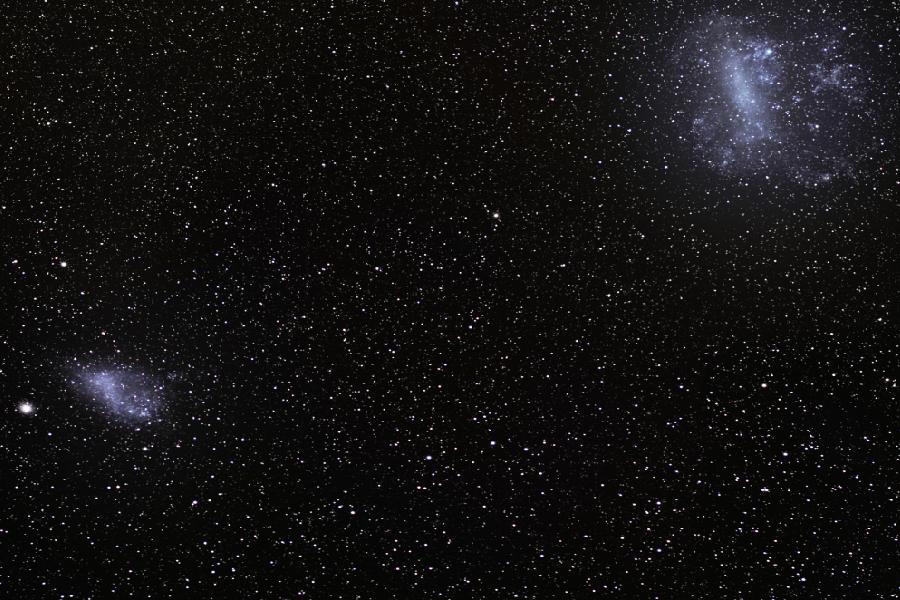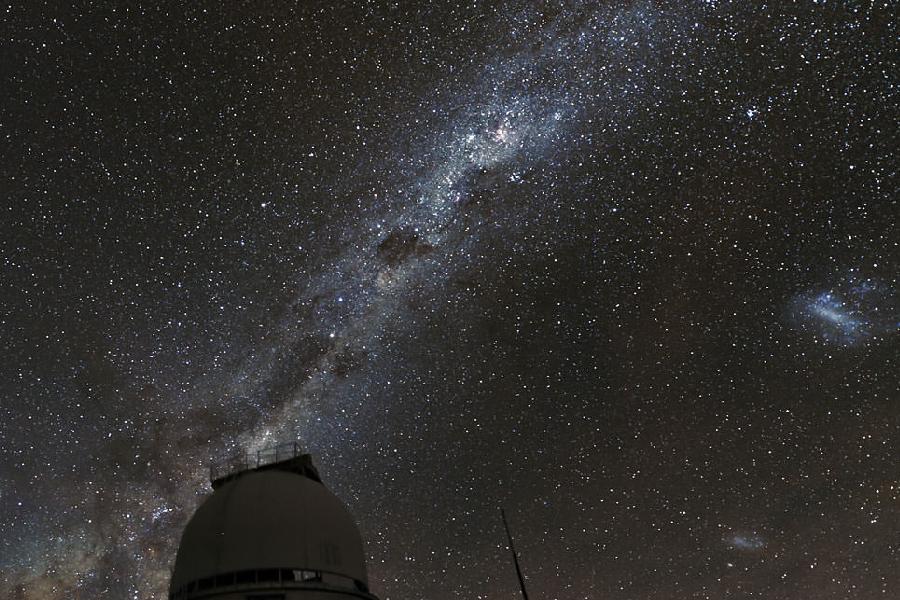Visible to the naked eye in the southern night sky are two hazy, irregular dwarf galaxies orbiting the Milky Way known as the Magellanic Clouds. Their ethereal glow has kindled myths and legends among ancient civilizations. Though named and observed since antiquity, much about the Magellanic Clouds has remained mysterious. So, what are Magellanic Clouds?
Known as the Large and Small Magellanic Clouds, these cosmic neighbors gravitationally dance, stretched into trails of gas, dust and stars by tidal forces. Long assumed to merely follow subordinate orbits around our galaxy, modern evidence unveils a far more dynamic history. This is well-explained by the unfolding story of the Magellanic Clouds−Earth system as an interacting group over billions of years.
So, we will explore the Magellanic Clouds definition, origins, internal structure and orbital path, tying them to the Milky Way. By weighing their ongoing co-evolution, we can project future patterns written in the heavens overhead for generations of stargazers on Earth.

What Are Magellanic Clouds?
The Magellanic Clouds are two irregular dwarf galaxies—Large Magellanic Cloud (LMC) and Small Magellanic Cloud (SMC)—orbiting our Milky Way galaxy. Visible in the southern hemisphere, these galaxies are named after the explorer Ferdinand Magellan.
Irregular shapes characterize the LMC and SMC. Also, they are nestled near the Milky Way, forming a captivating part of our galactic neighborhood. Despite their irregular appearance, the Magellanic Clouds are crucial in understanding galactic dynamics.
Hence, they provide insights into the gravitational interactions and complex processes shaping the structure of galaxies. Their proximity makes them prominent objects of study for astronomers. Plus, their unique features contribute to our broader comprehension of the diverse galactic ecosystem beyond the confines of the Milky Way.
Large Magellanic Cloud
Structure and characteristics
The Large Magellanic Cloud (LMC) shines as the Milky Way’s largest satellite galaxy. It spans over 14,000 light years—a brilliant example of a late-type barred Magellanic spiral galaxy.
Unlike symmetrical spirals, the LMC exhibits asymmetrical arms unevenly bursting with stellar birth on one half. This suggests massive tidal disruption of its structure through interactions. Also, infrared surveys reveal chaotic swaths of luminous young stars and gas clouds nourishing future starbursts.
Unique features and star formation
Harboring extremely active star-forming regions like the iconic Tarantula Nebula, the LMC manufactures new stars at an exceptionally rapid pace, enabled by its gas wealth.
Stripped from the Small Magellanic Cloud or accreted from intergalactic space during its journey, captured gas fuels special modes of star formation. The LMC is also home to Stars, which are gigantic yet magnetically bound convective hydrogen giants that lose enormous amounts of material via intense stellar winds.
Small Magellanic Cloud
Distinctive traits
While anchoring the Magellanic Bridge stretching from its famous sister galaxy, the Small Magellanic Cloud (SMC) exhibits its distinctive traits as a dwarf irregular galaxy. Unlike the LMC, its barred structure shows less symmetry, suggesting it formed in isolation.
Additionally, some bursts of star formation activity triggered by gravitational interaction have painted its structure with UV-bright stellar filaments. The glow emanates from short-lived massive stars soon fated to explosive endings.
Contribution to galactic ecology
The SMC’s small size renders it prone to gas loss from tidal forces and stellar feedback, disrupting fragile star-forming clouds. These stellar winds and supernovae expel processed heavy elements into the galactic vicinity.
The SMC shapes interstellar ecological succession, contributing to the regional cessation of star formation epochs. Simultaneously, its outflows enable new stellar generation cycles nearby as dispersed elements mix with primordial clouds again.

Magellanic Stream
Galactic interactions
The Magellanic Stream, an intriguing cosmic feature, is a vast trail of gas extending from the Magellanic Clouds across the intergalactic space. This captivating structure results from gravitational interactions between the Large and Small Magellanic Clouds (LMC and SMC) and our Milky Way.
The gravitational dance begins as the Magellanic Clouds, drawn by the Milky Way’s immense gravitational force, experience tidal interactions. These interactions strip away material, forming the Magellanic Stream.
So, it represents a bridge of gas connecting the Clouds to the Milky Way. This dynamic interplay showcases the profound impact of gravitational forces on galactic structures.
Impact on the dynamics
The Magellanic Stream significantly influences the dynamics of the Magellanic Clouds. As they lose material to the stream, it shapes their evolution and trajectory within the galactic neighborhood.
This continuous loss of gas alters the internal dynamics of the Clouds, influencing their star formation rates and overall galactic morphology. The stream acts as a cosmic storyteller, revealing the intricate narrative of gravitational interactions. It highlights their enduring impact on the structure and behavior of galaxies in our cosmic backyard.
Notable Celestial Objects Within Magellanic Clouds
Star clusters
Both Small and Large Magellanic Clouds host a spectacular array of stellar clusters and associations spanning a range of ages, compositions, and evolutionary phases.
Prominent globular clusters like NGC 121 in the SMC enable detailed stellar populations and dynamics analysis. Additionally, young superstar clusters like NGC 2070 in the LMC contribute to this analysis by providing insights into differing environments.
The Tarantula Nebula
The Tarantula Nebula within the LMC ranks among the most active starburst regions in Earth’s cosmic vicinity. Its glowing strands contain over 1,000 massive stars and up to 100 solar masses destined for cataclysmic supernova endings after millions of years. They enrich future nebula material.
Nebulae and supernova remnants
In addition to current stellar nurseries like the Tarantula Nebula, emissions from supernova blastwaves illuminate leftovers of former massive stars.
Analysis of remnants in the Veil Nebula unveils the haunted shells of progenitor stars once up to five times more massive than our sun. Such unique sites advance understanding of element dispersal and shockwave interactions.
Galactic Dynamics and Interaction With the Milky Way
Gravitational interplay
Like an intricate cosmic dance, the connections between the Small and Large Magellanic Clouds continue shaping their structures as they journey around the Milky Way together.
Gravitational tugs from their paired orbit and the Milky Way elongate their forms and shift trajectory. This sometimes promotes collisions and sets off fireworks of new star births.
Future trajectory
While predictions differ in details, multiple models indicate the Magellanic Clouds will eventually merge with our home Milky Way galaxy in 2-3 billion years. This is due to their orbital dance decays under gravitational forces.
This union will contribute their stars and gases, changing celestial ecosystems as existing stars reorder and new ones emerge from the seeded interstellar material in their wake.
Conclusion
What are Magellanic Clouds? We explored these two asymmetric dwarf galaxies as they spiral around our Milky Way and each other.
Rather than subordinate satellites, modern evidence reveals them to be long-standing partners in a cosmic group – influencing each other’s forms as they migrate. Their unfolding stories illustrate principles of gravitational dynamics and fuel the stellar ecology of the galaxies involved.
In the southern skies, humans across ages glimpse the same diffuse, glowing clouds. These clouds are immortalized in legend and are now studied to unveil the future tracks of galaxies, including perhaps our own.
The Magellanic Clouds’ combination of beauty, scientific revelation, and link across eras makes them an integral part of the fabric of humanity’s adventure. They play a crucial role in exploring our stellar neighborhood.
